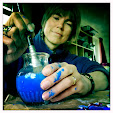The great thing about insects is that you can find them everywhere. You don't have to make a special trip to a nature reserve. They're in the garden, in the house, on the way to the shops... In a foreign country you don't even have to leave the airport before you see something new. Their stories are not as well-known as those of the larger animals, but are every bit as interesting.

We visited the morning opening of a moth trap at our local nature reserve, where I made this hurried sketch of a Poplar Hawkmoth. The names of the moths are lovely. Even the boring brown ones have beautiful names. We found Clouded Drab, Watered Carpet, Scalloped Hazel and Marbled Coronet.

The ditches in Taynish have been full of Four-spotted Chasers this past month. Recently though, with the emergence of the more aggressive Golden-ringed Dragonflies, they've had to keep a lower profile.

This year I finally managed to track down these Beautiful Demoiselle damselflies. They are only half a mile from my house, and it's extraordinary how such an iridescent insect could be so unobtrusive.

I'd seen a similar damselfly in France last year. It doesn't seem to occur in Britain and I can only find a latin name - Agrion haemorrhoidalis. This, presumably, for its pink bottom.

Lastly, in celebration of last-year's migration of Painted Lady Butterflies I made this painting. They reached us by the end of May, and carried on north over the horizon. If I want to follow them I'll have to buy a new road atlas now.





